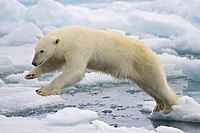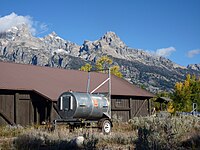Bear
| Bears Temporal range: Late Eocene – Recent
| |
|---|---|
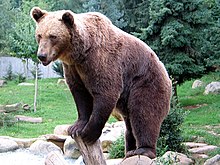
| |
| Brown bear (Ursus arctos) | |
| Scientific classification | |
| Domain: | Eukaryota |
| Kingdom: | Animalia |
| Phylum: | Chordata |
| Class: | Mammalia |
| Order: | Carnivora |
| Superfamily: | Ursoidea |
| Family: | Ursidae G. Fischer de Waldheim, 1817 |
| Type genus | |
| Ursus Linnaeus, 1758
| |
| Subfamilies | |
| |
Bears are
While the
Bears have been hunted since
Etymology
The English word "bear" comes from
Bear taxon names such as
Bear taxon names such as Ursidae and Ursus come from Latin Ursus/Ursa, he-bear/she-bear.
Taxonomy
The family Ursidae is one of nine families in the suborder Caniformia, or "doglike" carnivorans, within the order Carnivora. Bears' closest living relatives are the pinnipeds, canids, and musteloids[12] (some scholars formerly argued that bears are directly derived from canids and should not be classified as a separate family).[13] Modern bears comprise eight species in three subfamilies: Ailuropodinae (monotypic with the giant panda), Tremarctinae (monotypic with the spectacled bear), and Ursinae (containing six species divided into one to three genera, depending on the authority). Nuclear chromosome analysis show that the karyotype of the six ursine bears is nearly identical, each having 74 chromosomes (see Ursid hybrid), whereas the giant panda has 42 chromosomes and the spectacled bear 52. These smaller numbers can be explained by the fusing of some chromosomes, and the banding patterns on these match those of the ursine species, but differ from those of procyonids, which supports the inclusion of these two species in Ursidae rather than in Procyonidae, where they had been placed by some earlier authorities.[14]
Evolution
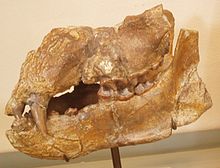
The earliest members of Ursidae belong to the extinct subfamily Amphicynodontinae, including

The raccoon-sized, dog-like Cephalogale is the oldest-known member of the subfamily Hemicyoninae, which first appeared during the middle Oligocene in Eurasia about 30 Mya.[16] The subfamily includes the younger genera Phoberocyon (20–15 Mya), and Plithocyon (15–7 Mya). A Cephalogale-like species gave rise to the genus Ursavus during the early Oligocene (30–28 Mya); this genus proliferated into many species in Asia and is ancestral to all living bears. Species of Ursavus subsequently entered North America, together with Amphicynodon and Cephalogale, during the early Miocene (21–18 Mya). Members of the living lineages of bears diverged from Ursavus between 15 and 20 Mya,[25][26] likely via the species Ursavus elmensis. Based on genetic and morphological data, the Ailuropodinae (pandas) were the first to diverge from other living bears about 19 Mya, although no fossils of this group have been found before about 11 Mya.[27][28]
The New World short-faced bears (Tremarctinae) differentiated from Ursinae following a dispersal event into North America during the mid-Miocene (about 13 Mya).[27] They invaded South America (≈2.5 or 1.2 Ma) following formation of the Isthmus of Panama.[29] Their earliest fossil representative is Plionarctos in North America (c. 10–2 Ma). This genus is probably the direct ancestor to the North American short-faced bears (genus Arctodus), the South American short-faced bears (Arctotherium), and the spectacled bears, Tremarctos, represented by both an extinct North American species (T. floridanus), and the lone surviving representative of the Tremarctinae, the South American spectacled bear (T. ornatus).[16]
The subfamily Ursinae experienced a dramatic proliferation of taxa about 5.3–4.5 Mya, coincident with major environmental changes; the first members of the genus
Phylogeny
The relationship of the bear family with other carnivorans is shown in the following
Note that although they are called "bears" in some languages, red pandas and raccoons and their close relatives are not bears, but rather musteloids.[33]
There are two phylogenetic hypotheses on the relationships among extant and fossil bear species. One is all species of bears are classified in seven subfamilies as adopted here and related articles:
| Ursidae |
| ||||||||||||||||||||||||
The second alternative phylogenetic hypothesis was implemented by McKenna et al. (1997) to classify all the bear species into the superfamily Ursoidea, with Hemicyoninae and Agriotheriinae being classified in the family "Hemicyonidae".
| Ursida |
| ||||||||||||||||||||||||||||||
| A possible phylogeny based on complete mitochondrial DNA sequences from Yu et al. (2007).[39] | ||||||||||||||||||||||||||||||||||||||||||||||||
|---|---|---|---|---|---|---|---|---|---|---|---|---|---|---|---|---|---|---|---|---|---|---|---|---|---|---|---|---|---|---|---|---|---|---|---|---|---|---|---|---|---|---|---|---|---|---|---|---|
| ||||||||||||||||||||||||||||||||||||||||||||||||
| The polar bear and the brown bear form a close grouping, while the relationships of the other species are not very well resolved.[14] |
| A more recent phylogeny based on the genetic study of Kumar et al. (2017).[40] | |||||||||||||||||||||||||||||||||||||||||||||
|---|---|---|---|---|---|---|---|---|---|---|---|---|---|---|---|---|---|---|---|---|---|---|---|---|---|---|---|---|---|---|---|---|---|---|---|---|---|---|---|---|---|---|---|---|---|
| |||||||||||||||||||||||||||||||||||||||||||||
| The study concludes that Ursine bears originated around 5 million years ago and show extensive hybridization of species in their lineage.[40] |
Physical characteristics
Size
The bear family includes the most massive extant terrestrial members of the order Carnivora.
Morphology

Bears are generally bulky and robust animals with short tails. They are sexually dimorphic with regard to size, with males typically being larger.[48][49] Larger species tend to show increased levels of sexual dimorphism in comparison to smaller species.[49] Relying as they do on strength rather than speed, bears have relatively short limbs with thick bones to support their bulk. The shoulder blades and the pelvis are correspondingly massive. The limbs are much straighter than those of the big cats as there is no need for them to flex in the same way due to the differences in their gait. The strong forelimbs are used to catch prey, excavate dens, dig out burrowing animals, turn over rocks and logs to locate prey, and club large creatures.[47]
Unlike most other land carnivorans, bears are plantigrade. They distribute their weight toward the hind feet, which makes them look lumbering when they walk. They are capable of bursts of speed but soon tire, and as a result mostly rely on ambush rather than the chase. Bears can stand on their hind feet and sit up straight with remarkable balance. Their front paws are flexible enough to grasp fruit and leaves. Bears' non-retractable claws are used for digging, climbing, tearing, and catching prey. The claws on the front feet are larger than those on the back and may be a hindrance when climbing trees; black bears are the most arboreal of the bears, and have the shortest claws. Pandas are unique in having a bony extension on the wrist of the front feet which acts as a thumb, and is used for gripping bamboo shoots as the animals feed.[47]
Most mammals have agouti hair, with each individual hair shaft having bands of color corresponding to two different types of melanin pigment. Bears however have a single type of melanin and the hairs have a single color throughout their length, apart from the tip which is sometimes a different shade. The coat consists of long guard hairs, which form a protective shaggy covering, and short dense hairs which form an insulating layer trapping air close to the skin. The shaggy coat helps maintain body heat during winter hibernation and is shed in the spring leaving a shorter summer coat. Polar bears have hollow, translucent guard hairs which gain heat from the sun and conduct it to the dark-colored skin below. They have a thick layer of blubber for extra insulation, and the soles of their feet have a dense pad of fur.[47] While bears tend to be uniform in color, some species may have markings on the chest or face and the giant panda has a bold black-and-white pelage.[50]
Bears have small rounded ears so as to minimize heat loss, but neither their hearing or sight are particularly acute. Unlike many other carnivorans they have
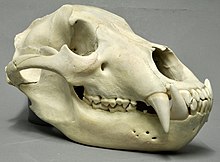
The
Bears have a fairly simple digestive system typical for carnivorans, with a single stomach, short undifferentiated intestines and no cecum.[54][55] Even the herbivorous giant panda still has the digestive system of a carnivore, as well as carnivore-specific genes. Its ability to digest cellulose is ascribed to the microbes in its gut.[56] Bears must spend much of their time feeding in order to gain enough nutrition from foliage. The panda, in particular, spends 12–15 hours a day feeding.[57]
Distribution and habitat
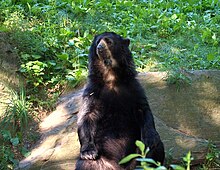
Extant bears are found in sixty countries primarily in the Northern Hemisphere and are concentrated in Asia, North America, and Europe. An exception is the spectacled bear; native to South America, it inhabits the Andean region.[58] The sun bear's range extends below the equator in Southeast Asia.[59] The Atlas bear, a subspecies of the brown bear was distributed in North Africa from Morocco to Libya, but it became extinct around the 1870s.[60]
The most widespread species is the brown bear, which occurs from Western Europe eastwards through Asia to the western areas of North America. The American black bear is restricted to North America, and the polar bear is restricted to the Arctic Sea. All the remaining species of bear are Asian.[58] They occur in a range of habitats which include tropical lowland rainforest, both coniferous and broadleaf forests, prairies, steppes, montane grassland, alpine scree slopes, Arctic tundra and in the case of the polar bear, ice floes.[58][61] Bears may dig their dens in hillsides or use caves, hollow logs and dense vegetation for shelter.[61]
Behavior and ecology

Brown and American black bears are generally
Feeding
Most bears are opportunistic
When foraging for plants, bears choose to eat them at the stage when they are at their most nutritious and digestible, typically avoiding older

The sloth bear is not as specialized as polar bears and the panda, has lost several front teeth usually seen in bears, and developed a long, suctioning tongue to feed on the ants, termites, and other burrowing insects. At certain times of the year, these insects can make up 90% of their diets.[77] Some individuals become addicted to sweets in garbage inside towns where tourism-related waste is generated throughout the year.[78] Some species may raid the nests of wasps and bees for the honey and immature insects, in spite of stinging from the adults.[79] Sun bears use their long tongues to lick up both insects and honey.[80] Fish are an important source of food for some species, and brown bears in particular gather in large numbers at salmon runs. Typically, a bear plunges into the water and seizes a fish with its jaws or front paws. The preferred parts to eat are the brain and eggs. Small burrowing mammals like rodents may be dug out and eaten.[81][69]
The brown bear and both species of black bears sometimes take large ungulates, such as
Bears are prolific
Communication
Bears produce a number of vocal and non-vocal sounds. Tongue-clicking, grunting or chuffing many be made in cordial situations, such as between mothers and cubs or courting couples, while moaning, huffing, snorting or blowing air is made when an individual is stressed. Barking is produced during times of alarm, excitement or to give away the animal's position. Warning sounds include jaw-clicking and lip-popping, while teeth-chatters, bellows, growls, roars and pulsing sounds are made in aggressive encounters. Cubs may squeal, bawl, bleat or scream when in distress and make motor-like humming when comfortable or nursing.[52][88][89][90][91][92]
Bears sometimes communicate with visual displays such as
Bears also communicate with their scent and will rub it against trees and other objects.[94] This is usually accompanied by clawing and biting the object. Bark may be spread around to draw attention to the marking post.[95] Pandas establish territories by marking objects with urine and a waxy substance from their anal glands.[96] Polar bears leave behind their scent in their tracks which allow individuals to keep track of one another in the vast Arctic wilderness.[97]
Reproduction and development
The mating system of bears has variously been described as a form of
In some species, offspring may become independent around the next spring, though some may stay until the female successfully mates again. Bears reach sexual maturity shortly after they disperse; at around 3–6 years depending on the species. Male Alaskan brown bears and polar bears may continue to grow until they are 11 years old.[101] Lifespan may also vary between species. The brown bear can live an average of 25 years.[108]
Hibernation
Bears of northern regions, including the American black bear and the grizzly bear, hibernate in the winter.[109][110] During hibernation, the bear's metabolism slows down, its body temperature decreases slightly, and its heart rate slows from a normal value of 55 to just 9 beats per minute.[111] Bears normally do not wake during their hibernation, and can go the entire period without eating, drinking, urinating, or defecating.[47] A fecal plug is formed in the colon, and is expelled when the bear wakes in the spring.[112] If they have stored enough body fat, their muscles remain in good condition, and their protein maintenance requirements are met from recycling waste urea.[47] Female bears give birth during the hibernation period, and are roused when doing so.[110]
Mortality

Bears do not have many predators. The most important are humans, and as they started cultivating crops, they increasingly came in conflict with the bears that raided them. Since the invention of firearms, people have been able to kill bears with greater ease.
Bears are parasitized by eighty species of parasites, including single-celled protozoans and gastro-intestinal worms, and nematodes and flukes in their heart, liver, lungs and bloodstream. Externally they have ticks, fleas and lice. A study of American black bears found seventeen species of endoparasite including the protozoan Sarcocystis, the parasitic worm Diphyllobothrium mansonoides, and the nematodes Dirofilaria immitis, Capillaria aerophila, Physaloptera sp., Strongyloides sp. and others. Of these, D. mansonoides and adult C. aerophila were causing pathological symptoms.[116] By contrast, polar bears have few parasites; many parasitic species need a secondary, usually terrestrial, host, and the polar bear's life style is such that few alternative hosts exist in their environment. The protozoan Toxoplasma gondii has been found in polar bears, and the nematode Trichinella nativa can cause a serious infection and decline in older polar bears.[117] Bears in North America are sometimes infected by a Morbillivirus similar to the canine distemper virus.[118] They are susceptible to infectious canine hepatitis (CAV-1), with free-living black bears dying rapidly of encephalitis and hepatitis.[119]
Relationship with humans
Conservation
In modern times, bears have come under pressure through encroachment on their habitats
Laws have been passed in many areas of the world to protect bears from
Attacks

Several bear species are dangerous to humans, especially in areas where they have become used to people; elsewhere, they generally avoid humans. Injuries caused by bears are rare, but are widely reported.[129] Bears may attack humans in response to being startled, in defense of young or food, or even for predatory reasons.[130]
Entertainment, hunting, food and folk medicine
Bears in captivity have for centuries been used for entertainment. They have been trained to
The peoples of eastern Asia use bears' body parts and secretions (notably their gallbladders and bile) as part of traditional Chinese medicine. More than 12,000 bears are thought to be kept on farms in China, Vietnam, and South Korea for the production of bile. Trade in bear products is prohibited under CITES, but bear bile has been detected in shampoos, wine and herbal medicines sold in Canada, the United States and Australia.[136]
-
The Dancing Bear by William Frederick Witherington, 1822
-
A nomadicursar, a Romani bear-busker. Drawing by Theodor Aman, 1888
Cultural depictions
Bears have been popular subjects in art, literature, folklore and mythology. The image of the mother bear was prevalent throughout societies in North America and Eurasia, based on the female's devotion and protection of her cubs.
There is evidence of prehistoric
The constellations of Ursa Major and Ursa Minor, the great and little bears, are named for their supposed resemblance to bears, from the time of Ptolemy.[b][8] The nearby star Arcturus means "guardian of the bear", as if it were watching the two constellations.[148] Ursa Major has been associated with a bear for as much as 13,000 years since Paleolithic times, in the widespread Cosmic Hunt myths. These are found on both sides of the Bering land bridge, which was lost to the sea some 11,000 years ago.[149]
Bears are popular in children's stories, including
Bears, like other animals, may symbolize nations. The Russian Bear has been a common national personification for Russia from the 16th century onward.[160] Smokey Bear has become a part of American culture since his introduction in 1944, with his message "Only you can prevent forest fires".[161]
-
"The Three Bears", Arthur Rackham's illustration to English Fairy Tales, by Flora Annie Steel, 1918
Organizations

The International Association for Bear Research & Management, also known as the
Specialty organizations for each of the eight species of bears worldwide include:
- Vital Ground, for the brown bear[163]
- Moon Bears, for the Asiatic black bear[164]
- Black Bear Conservation Coalition, for the North American black bear[165]
- Polar Bears International, for the polar bear[166]
- Bornean Sun Bear Conservation Centre, for the sun bear[167]
- Wildlife SOS, for the sloth bear[168]
- Andean Bear Conservation Project, for the Andean bear[169]
- Chengdu Research Base of Giant Panda Breeding, for the giant panda[170]
See also
Notes
References
Citations
- OCLC 139999117.
- OCLC 778339290.
- ISBN 978-0-19-251118-8.
- ^ "bear (n.)". Online Etymology Dictionary. Archived from the original on 2017-02-02. Retrieved 22 January 2017.
- ^ Postma, Laura. "The word for "bear"". University of Pittsburgh Slovak Studies Program. Archived from the original on 2017-11-22. Retrieved 21 March 2018.
- ^ Silver, Alexandra (10 January 2011). "Hooking Up and Using the John: Why Do We Use So Many Euphemisms?". Time. Retrieved 4 April 2019.
- ^ Liddell, Henry George; Scott, Robert. Arktos. Perseus Digital Library.
{{cite encyclopedia}}:|work=ignored (help) - ^ a b c "The Great Bear Constellation Ursa Major". Archived from the original on 30 November 2010. Retrieved 12 January 2017.
- ^ "Ursa Major – the Greater Bear". constellationsofwords.com. Archived from the original on 2015-03-14. Retrieved 11 March 2015.
- ^ "Bernhard Family History". ancestry.com. Archived from the original on 2015-04-02. Retrieved 11 March 2015.
- ^ Sweet, Henry (1884) Anglo-Saxon Reader in Prose and Verse. The Clarendon Press, p. 202.
- S2CID 86755875.
- ^ S2CID 91124592.
- ^ ISBN 978-2-8317-0462-3. Archived(PDF) from the original on 2022-10-09.
- ISBN 978-0-19-850760-4.
- ^ (PDF) from the original on 2009-03-26.
- ^ Tedford, R.H.; Barnes, L.G.; Ray, C.E. (1994). "The early Miocene littoral ursoid carnivoran Kolponomos: Systematics and mode of life" (PDF). Proceedings of the San Diego Society of Natural History. 29: 11–32. Archived from the original (PDF) on 22 September 2012.
- ^ Tedford, R.H.; Barnes, L.G.; Ray, C.E. (1994). "The early Miocene littoral ursoid carnivoran Kolponomos: Systematics and mode of life" (PDF). Proceedings of the San Diego Society of Natural History. 29: 11–32. Archived from the original (PDF) on 22 September 2012. Retrieved 24 July 2010.
- ^ S2CID 4371413.
- ^ S2CID 135439365.
- ^ Hunt, R.M. Jr.; Barnes, L.G. (1994). "Basicranial evidence for ursid affinity of the oldest pinnipeds" (PDF). Proceedings of the San Diego Society of Natural History. 29: 57–67.
- PMID 7877495.
- S2CID 59126616.
- PMID 17996107.
- PMID 10508542. Archived from the original(PDF) on 3 September 2015.
- PMID 18328735.
- ^ PMID 18662376.
- PMID 23155439.
- hdl:10915/5366.
- (PDF) from the original on 26 March 2009.
- ^ Ward & Kynaston 1995, pp. 74–77
- PMID 24813606.
- ^ PMID 16012099.
- PMID 28472434.
- .
- S2CID 131561629.
- ^ a b Qiu, Zhan-Xiang; et al. (2014). "A Late Miocene Ursavus skull from Guanghe, Gansu, China". Vertebrata PalAsiatica. 52 (3): 265–302.
- ^ ISBN 978-0-231-52853-5.
- PMID 17956639.
- ^ PMID 28422140.
- ^ Illiger, J. K. W. (1811). Prodromus Systematis Mammalium et Avium (in Latin). Sumptibus C. Salfeld. pp. 138–39.
- ^ Ward & Kynaston 1995, p. 61
- ISBN 978-0-7368-0031-0.
- S2CID 198969265.
- ^ Dell'Amore, C. (February 3, 2011), Biggest Bear Ever Found, National Geographic News, archived from the original on 2017-10-17
- from the original on 2011-03-10. Retrieved 2011-06-01.
- ^ ISBN 978-0-7614-7882-9.
- .
- ^ ISBN 978-0-521-35519-3.
- ^ a b Ward & Kynaston 1995, pp. 124–125
- ISBN 978-0-87196-871-5.
- ^ a b Ward & Kynaston 1995, pp. 117–121
- PMID 11322723.
- ISBN 978-0-8018-7416-1.
- ^ a b c "Food Habits of Grizzly Bears and Black Bears in the Yellowstone Ecosystem". National Park Service. Archived from the original on 2017-01-28. Retrieved 18 January 2017.
- PMID 20010809.
- ^ a b c d Ward & Kynaston 1995, p. 83
- ^ ISBN 978-2-8317-0462-3.
They are opportunistic omnivores whose diet varies from plant foliage, roots, and fruits; insect adults, larvae, and eggs; animal matter from carrion; animal matter from predation; and fish. Their dentition and digestive system reflects this varied diet.
- ^ Ward & Kynaston 1995, p. 52
- PMID 10877599.
- ^ ISBN 978-0-8018-8032-2.
- doi:10.1139/Z02-123. Archived(PDF) from the original on 2017-08-12. Retrieved 2017-01-07.
- ^ Ward & Kynaston 1995, p. 99
- ISBN 978-1-4613-0855-3.
- ^ (PDF) from the original on 2013-07-22. Retrieved 2017-01-11.
- ^ Ward & Kynaston 1995, p. 130
- PMID 36085304.
- ^ a b Hwang, Mei-Hsiu (2002). "Diets of Asiatic black bears in Taiwan, with Methodological and Geographical Comparisons" (PDF). Ursus. 13: 111–125. Archived (PDF) from the original on 2013-07-23. Retrieved 2012-12-22.
- ^ a b c d e Mattson, David. "Foraging Behavior of North American Bears" (PDF). Southwest Biological Science Center. Archived from the original (PDF) on 11 July 2007.
- ISBN 978-0-517-53942-2.
- JSTOR 3873160.
- S2CID 59040812.
- ISBN 978-0-06-120578-1.
- ^ Ward & Kynaston 1995, pp. 89–92
- ^ Dolberg, Frands (1 August 1992). "Progress in the utilization of urea-ammonia treated crop residues: biological and socio-economic aspects of animal production and application of the technology on small farms". University of Arhus. Archived from the original on 2011-07-07. Retrieved 10 August 2010.
- ^ Ward & Kynaston 1995, p. 87
- JSTOR 1382910.
- S2CID 233677898.
- ^ "What do bears like to eat in a beehive?". North American Bear Center. Archived from the original on 2017-04-06. Retrieved 5 April 2017.
- ^ Ward & Kynaston 1995, p. 89
- ^ a b c d Ward & Kynaston 1995, pp. 93–98
- S2CID 85857613.
- ^ "Animal Protein". North American bear Center. Archived from the original on 2017-03-23. Retrieved 22 March 2017.
- ^ Ward & Kynaston 1995, p. 92
- .
- Environment Canada. Archived(PDF) from the original on 2022-10-09. Retrieved 8 April 2007.
- ^ Ward & Kynaston 1995, p. 104
- ISBN 978-1-4426-4483-0.
- ^ "Vocalizations and Body Language". North American Bear Center. Archived from the original on 2016-12-23. Retrieved 7 January 2017.
- ISBN 978-1-936555-61-1.
- (PDF) from the original on 2014-02-03. Retrieved 2017-09-08.
- (PDF) from the original on 2017-03-27. Retrieved 2017-03-26.
- S2CID 89660730.
- S2CID 54371123.
- ^ Ward & Kynaston 1995, p. 122
- S2CID 53256022.
- .
- ^ Eide, S.; Miller, S. "Brown Bear" (PDF). Alaska Department of Fish and Game. Archived (PDF) from the original on 2013-03-03. Retrieved 14 January 2016.
- ^ a b Ward & Kynaston 1995, pp. 138–141
- ^ S2CID 198968922. Archived from the original(PDF) on 2016-03-16.
- ^ a b c Ward & Kynaston 1995, pp. 144–148
- ^ "Panda Facts". Pandas International. Archived from the original on 24 September 2015. Retrieved 26 August 2015.
- ^ Ward & Kynaston 1995, p. 132
- (PDF) from the original on 2016-12-21. Retrieved 2017-05-02.
- PMID 16543170.
- from the original on 2017-11-16. Retrieved 2017-01-14.
- PMID 16107663.
- ^ "Grizzly Bear". National Geographic.com. 10 September 2010. Archived from the original on 2017-04-21. Retrieved 29 April 2017.
- S2CID 31514297.
- ^ S2CID 86174817.
- S2CID 20829847.
- ^ Biel, M; Gunther, K. "Denning and Hibernation Behavior". Yellowstone National Park. National Park Service. Archived from the original on 2016-11-18. Retrieved 18 November 2016.
- JSTOR 3872596.
- ^ Seryodkin, Ivan (2006). The ecology, behavior, management and conservation status of brown bears in Sikhote-Alin (in Russian). Far Eastern National University, Vladivostok, Russia. pp. 1–252. Archived from the original on 2013-12-24.
- ^ Seryodkin; et al. (2003). "Denning ecology of brown bears and Asiatic black bears in the Russian Far East". Ursus. 14 (2): 159. Archived from the original on 2011-08-17. Retrieved 2014-10-05.
- PMID 418189.
- ISBN 978-1-4214-0305-2.
- ISBN 978-2-7420-0392-1.
- ISBN 978-0-470-34481-1.
- ^ "Brown Bear – Threats Grizzlies: Found in 2% of their former range". WWF. Archived from the original on 2016-12-21. Retrieved 16 January 2017.
- ^ Bacon, Heather (12 May 2008). "Implications of bear bile farming". Vet Times. Archived from the original on 2017-01-18. Retrieved 16 January 2017.
- ^ IUCN. Archivedfrom the original on 2011-08-05. Retrieved 16 January 2017.
- ISBN 978-2-8317-0462-3.
- S2CID 39632061.
- S2CID 58919830.
- ^ "Pandas gain world heritage status". BBC News. 12 July 2006. Retrieved 2019-08-22.
- ^ S2CID 55185188.
- S2CID 26961091.
- ^ Clark, Douglas (2003). "Polar Bear–Human Interactions in Canadian National Parks, 1986–2000" (PDF). Ursus. 14 (1): 65–71. Archived (PDF) from the original on 2013-07-22. Retrieved 2012-12-22.
- ^ Than, K. (2013). "Maulings by Bears: What's Behind the Recent Attacks?". National Geographic.com. Archived from the original on 2017-01-28. Retrieved 16 January 2017.
- ISBN 978-0-253-02637-8.
- ^ "Elizabethan Playhouses and Bear Baiting Arenas Given Protection". Historic England. 26 September 2016. Archived from the original on 2017-01-04. Retrieved 4 January 2017.
- ISBN 978-0-631-19605-1.
- ^ "Trichinellosis Associated with Bear Meat". Archived from the original on 30 September 2006. Retrieved 4 October 2006.
- ^ "Bear meat poisoning in Siberia". BBC News. 21 December 1997. Archived from the original on 2008-12-11. Retrieved 4 October 2006.
- ^ Black, Richard (11 June 2007). "BBC Test kit targets cruel bear trade". BBC News. Archived from the original on 15 January 2009. Retrieved 1 January 2010.
- ^ Ward & Kynaston 1995, pp. 12–13
- ^ Ward & Kynaston 1995, p. 17
- ^ Ward & Kynaston 1995, pp. 20–21
- S2CID 53595088.
- S2CID 155380619.
- JSTOR 1255969.
- ISBN 978-1-56098-661-4.
- ISBN 978-90-279-3378-2.
- ISBN 978-0-7864-2248-7.
- ^ Burkert, Walter, Greek Religion, 1985:263.
- ^ Ridpath, Ian. "Ptolemy's Almagest First printed edition, 1515". Retrieved 13 January 2017.
- ^ Liddell, Henry George; Scott, Robert. "Ἀρκτοῦρος". A Greek-English Lexicon. Perseus. Archived from the original on 2017-03-07. Retrieved 23 January 2017.
- .
- ^ "Pooh celebrates his 80th birthday". BBC News. 24 December 2005. Archived from the original on 2006-04-25. Retrieved 23 January 2017.
- ^ "About". Paddington.com. Archived from the original on 17 August 2016. Retrieved 19 January 2017.
- ^ "Walt Morey, 84; Author of 'Gentle Ben'". Los Angeles Times. Associated Press. 14 January 1992. Archived from the original on 2016-10-23. Retrieved 6 April 2017.
- ^ Kennedy, Patrick, ed. (1866). "The Brown Bear of Norway". Legendary Fictions of the Irish Celts. Macmillan. pp. 57–67.
- JSTOR 539519.
- ISBN 978-0-313-32810-7.
- ISBN 978-0-88363-108-9.
- ISBN 978-0-87972-821-2.
- ^ Holmes, Elizabeth (9 February 2007). "Care Bears Receive a (Gentle) Makeover". The Wall Street Journal. Archived from the original on 2018-01-18. Retrieved 27 January 2017.
- ^ Cannadine, David (1 February 2013). "A Point of View: The grownups with teddy bears". BBC. Archived from the original on 2017-04-25. Retrieved 21 January 2017.
- ^ "What the West thinks about Russia is not necessarily true". Telegraph. 23 April 2009. Archived from the original on 2015-12-06. Retrieved 3 January 2017.
- ^ "Forest Fire Prevention – Smokey Bear (1944–Present)". Ad Council. 1944-08-09. Archived from the original on 2010-12-02. Retrieved 2010-10-16.
- ^ "Vision and Mission". Bear Trust International. 2002–2012. Archived from the original on 2014-02-26. Retrieved 8 March 2014.
- ^ "Vital Ground". Archived from the original on 2019-01-20. Retrieved 2019-02-05.
- ^ "Moon Bears". Archived from the original on 2014-03-09. Retrieved 2014-03-09.
- ^ "Black Bear Conservation Coalition". Archived from the original on 2014-01-03. Retrieved 2014-03-09.
- ^ "Polar Bears International". Archived from the original on 2014-03-08. Retrieved 2014-03-09.
- ^ "Bornean Sun Bear Conservation Centre". Archived from the original on 2014-02-18.
- ^ "Wildlife SOS - Saving India's Wildlife". Wildlife SOS.
- ^ "Andean Bear Conservation Project". Archived from the original on 2014-02-18. Retrieved 2014-03-09.
- ^ "Chengdu Research Base of Giant Panda Breeding". Archived from the original on 2014-03-15. Retrieved 2014-03-09.
General and cited references
- Ward, Paul; Kynaston, Suzanne (1995). Wild Bears of the World. New York: Facts on File. OCLC 443610490.
Further reading
- Brunner, Bernd (2007). Bears: A Brief History. Yale University Press. ISBN 978-0-300-12299-2.
- Domico, Terry; Newman, Mark (1988). Bears of the World. Facts on File. ISBN 978-0-8160-1536-8.
- ISBN 978-0-7927-0537-6.

